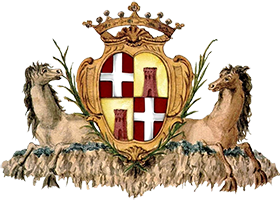
Sassari
If there is a place that is quintessentially 'Angioyan,' it is undoubtedly Sassari.
Despite the incidents that erupted in the city and throughout Logudoro during that three-year period, Sassari steadfastly preserved the memory of the Alternos’ figure and labour for generations. A revolution spread over the length and width of Capo di Sopra’s capital: first a stronghold of the reactionary aristocracy and the home of the notorious Duke of Asinara, then a bulwark of Angioy’s adherents, and last a haven for the most fervent republican and independence radicals.
Sassari went through all of the most intense periods that defined those years: from its capture by the revolutionary army in the final days of 1795 to its use as the headquarters of the progressive Alternos government in the spring of the following year, and finally, to the tragic epilogue of 1802, where Piazza Tola played host to the last, desperate attempt and the terrible, tragic demise of the notary Cilocco.
However, the bitter remembrance of those events cannot obscure the truth that the seeds of the Sardinian Revolution were sowed in the age-old lecture rooms of the rebuilt Turretan university. Angioy launched the island’s’revolution of ideas from this location.
Among the law graduates of those years, who were to be protagonists in various capacities of the Sardinian Revolution, one should remember Domenico Simon, Gioachino Mundula, Gavino Fadda, Francesco Sotgiu Satta, Domenico and Salvatore Pinna, Michele Obino, as well as Domenico Alberto Azuni, who graduated on 29 January 1772. During the Sardinian Revolution, law graduates such as Domenico Simon, Gioachino Mundula, Gavino Fadda, Francesco Sotgiu Satta, Domenico and Salvatore Pinna, Michele Obino, Domenico Alberto Azuni (who graduated on January 29, 1772), theologians Muroni, Sanna Corda, Tanca di Thiesi, Sechi Bologna, Aragonez, Niccolò Angioy, and the Sisternes, as well as doctors who dedicated their lives to the cause, should be remembered. subsequently should not be forgotten that, in an instance that is more unusual than common, the Turritan University fired two professors—Michele Obino of Santu Lussurgiu, a lecturer in Decretals, and Antonio Campus of Pattada, a lecturer in Moral Theology—from their positions as instructors ‘for political reasons’ because of their overt support of the Sardinian Revolution.
A sense of belonging to the Sardinian nation, enhanced by strong cultural foundations, was fruitfully blossomed as a result of this profound legacy. This sense of pride manifested itself in a serious and thorough examination of the legislation of the homeland, which includes Sardinian sovereign institutions, the Sardinian national idiom, and the island’s economic structures.
The Rosello Fountain
This fountain is referenced in the Sassaresi Statutes going back to the late 13th century and is located in the same valley. It was the only fountain to rise beyond the city walls, and it was crucial to the city’s water supply. The Eba Giara rivulet, which derives its name from the Roman aqueduct known as the AQVA CLARA that carried precious water to the Roman colony of Turris Lybissonis, today’s Porto Torres, for a distance of approximately 20 Roman miles, is fed by several subterranean streams.
Ligurian artisans most likely created the current appearance over many projects between the end of the 16th and the start of the 17th centuries.
It essentially consists of two parallelepipeds placed on top of one another that are coated in fine white and dark grey marble. The biggest parallelepiped at the bottom has twelve cantaros (mouths), most of which are in the shape of lion heads symbolising the months, while four statues at each corner representing the four seasons of the year. Four arches branch forth from the smallest one at the top and come together to support the statue of Saint Gavino.
Almost all of the sculptures illustrating the seasons were destroyed during the revolutionary uprisings in 1795, with the exception of the Summer, which is preserved in the Ducal Palace.
This is not only considered the symbol of Sassari, but also the most important and, for some, the only monumental fountain in Sardinia, so much so that it was chosen by the Italian Postal Service to be included in a 1975 series of stamps featuring Italy’s most beautiful ornamental fountains.
Curiosity
Almost all of the sculptures illustrating the seasons were destroyed during the revolutionary uprisings in 1795, with the exception of the Summer, which is preserved in the Ducal Palace. This is not only considered the symbol of Sassari, but also the most important and, for some, the only monumental fountain in Sardinia, so much so that it was chosen by the Italian Postal Service to be included in a 1975 series of stamps featuring Italy's most beautiful ornamental fountains.
The University Square
Situated on the southern edge of the city walls, the square is close to the historic Porta Nuova. The Jesuit college was constructed on the “corte Boneta“, an area next to the walls, with the help of numerous wealthy donors, notably Alessio Fontana, the chancellor of Charles V of Spain, and Antonio Canopolo, the archbishop of Oristano, who was originally from Sassari.
The Jesuits started building its Studio Generale, also known as St. Joseph’s institution, in 1611, and they worked so fast that when it was finished in 1617, King Philip III of Spain gave the Sassari institution the title of Royal University. In October 1632, Philip IV granted the University of Sassari permission to provide degrees in both medicine and law, however this licence was not put into practise until a year later. Before enrolling in a legal studies degree at the University of Cagliari, a very young Giommaria Angioy studied for a year at this institution’s Faculty of Theology.
Piazza Tola
It served as a marketplace and a site of execution for the lower classes from the Middle Ages and up to the 18th century. Around the sixteenth century, modest, popular cottages were occupied there; they were eventually removed to reshape the square roughly to its current state.
Above the dedicatory epigraph, on the ruins of another late Gothic building, one can discern the easily identifiable Palazzo d’Usini, constructed by Don Jayme Manca di Mores, Lord of Usini and Tissi and Baron of Ossi, as confirmed by the engraving on the archivolt key of the portal circa 1577.
Later, on the date of Francesco Cilloco’s heroic death, Don Antonio Manca di Mores lived there as well. From a palace window, he encouraged Cilloco‘s torturer to beat him mercilessly before hanging him.
The Saint Nicholas Cathedral
Although the exact date of the original foundation upon which the church was built is unknown, it seems that a place of worship dedicated to St. Nicholas and even earlier, to the Madonna del Bosco, existed in Sassari around the 12th century (c. 1135), according to the Condaghes of St. Peter of Silki. It is known with certainty that, up until 1278, this was the sole house of worship in the region; it was also close to this temple that the first urban nucleus of what would become Thàthari emerged.
This ecclesiastical edifice was built on a pre-existing early Christian structure. It appears that the original reconstruction occurred in the 13th century in the Romanesque style, remains of which can still be seen beneath the apse. Later, in the 15th century, it assumed a Catalan-Gothic appearance, evolving from a simple church to a cathedral at the turn of the 1440s and 1441.
Built during the height of the Spanish era in the 17th century, the Baroque façade is the last in chronological order and has a striking visual effect.
Bibliography
“Sassari. Storia architettonica e urbanistica dalle origini al ‘600”, Marisa Porcu Gaias.
Credits
S. Campana, A. Nasone, S.A.Tedde.



